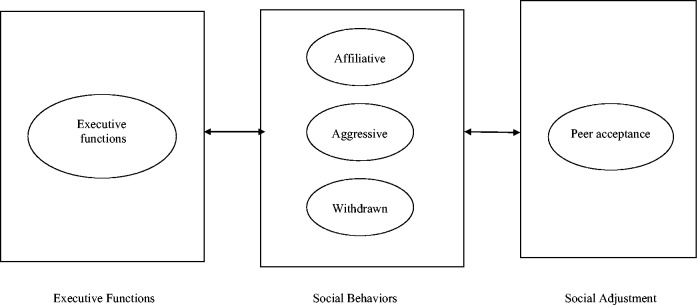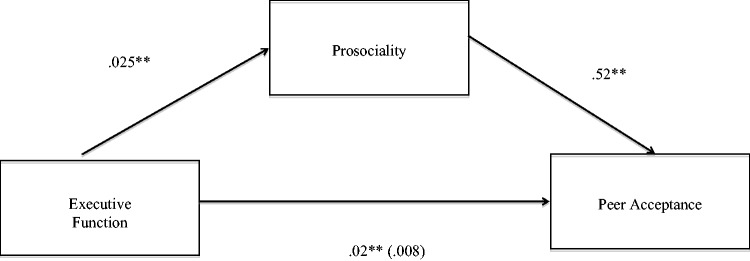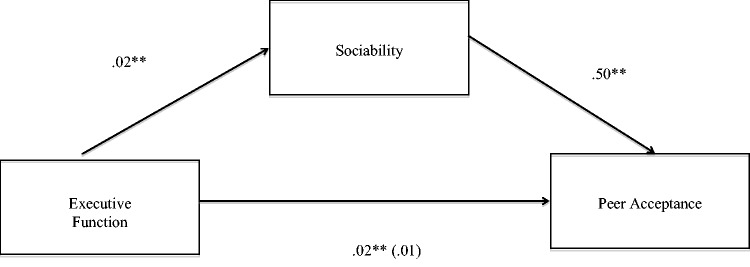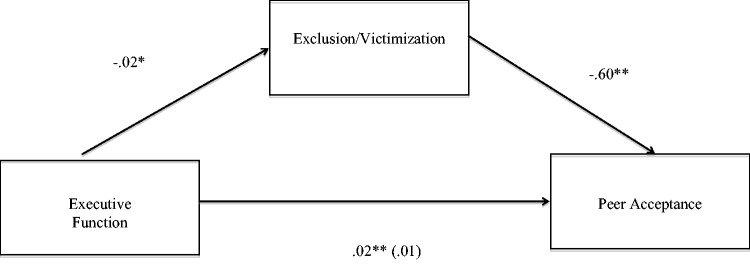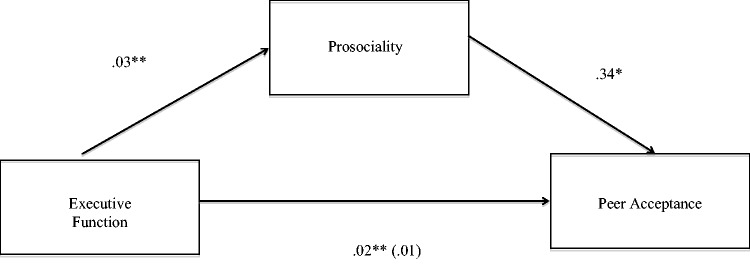Abstract
Objective The goal of the current study was to test a proposed model of social competence for children who have suffered a traumatic brain injury (TBI). We hypothesized that both peer and teacher reports of social behavior would mediate the relation between intraindividual characteristics (e.g., executive function) and peer acceptance. Methods Participants were 52 children with TBI (M age = 10.29; M time after injury: 2.46 years). Severity of TBI ranged from complicated mild to severe. Classroom and laboratory measures were used to assess executive function, social behavior, and peer acceptance. Results Analyses revealed that peer reports of social behavior were a better mediator than teacher reports of the associations between executive function, social behaviors, and peer acceptance. Discussion The results underscore the importance of including peer reports of social behavior when developing interventions designed to improve the social, emotional, and behavioral outcomes of children with TBI.
Keywords: psychosocial functioning, school functioning, social skills and development
Traumatic brain injury (TBI) in childhood has been associated with various maladaptive behavioral, cognitive, and social outcomes (Anderson et al., 2013; Bohnert, Parker, & Warschausky, 1997; Janusz, Kirkwood, Yeates, & Taylor, 2002). Researchers who have studied social outcomes related to childhood TBI have begun to integrate interdisciplinary models into their work in an effort to better understand the transactional nature of these different domains (Beauchamp & Anderson, 2010; Yeates et al., 2014). Drawing from social developmental research, one such model focuses on three dimensions of social competence: executive function (EF), social behaviors, and peer acceptance (Yeates et al., 2007; Figure 1). The model proposes that EFs give rise to social behaviors, whether they be aggressive, affiliative, or withdrawn, which in turn influence the extent to which members of the social community (e.g., peers, teachers) perceive the child to be socially adjusted.
Figure 1.
Model of social competence in children with brain disorder (Yeates et al., 2007).
Social competence has been defined as the achievement of personal goals during social interactions, while maintaining positive social relationships across time and across various contexts (Rubin & Rose-Krasnor, 1992). One of the key elements of social competence is EF, which comprises cognitive resources related to attentional control, mental flexibility, and goal setting. The critical skills associated with the construct of EF are putatively essential for adaptive behavioral regulation and the development of social competence (Anderson, 2008; Holbein et al., 2015; Lennon, Klages, Amaro, Murray, & Holmbeck, 2015). Thus, for the purposes of this study, we focused on the relations between EF, social behavior, and peer acceptance.
Social behaviors comprise those actions displayed when children are in social company (e.g., the peer group). Generally, social behaviors are characterized by three broad tendencies: (1) moving toward others (e.g. affiliation), (2) moving against others (e.g., aggressive behaviors), and (3) moving away from others (e.g., socially withdrawing from others) (Rubin, Bukowski, & Bowker, 2015). Lastly, peer acceptance refers to how well children get along with others and the extent to which others view the child’s social behavior as acceptable or aversive (Crick & Dodge, 1994).
EF and TBI in Childhood
Deficits in social behaviors following TBI seem to indicate disruption in appropriate, adaptive, cognitive, and neural processes (Rosema, Crowe, & Anderson, 2012; Yeates et al., 2014). EFs are necessary for adaptive behavioral regulation (Ganesalingam, et al., 2011). Poor performance on EF tasks has been associated with behavioral maladjustment in children with TBI (e.g., Muscara, Catroppa, & Anderson, 2008).
Peer Acceptance, Exclusion, and Victimization
It is not well established, within the TBI literature, whether EF and behavioral functioning affect an individual’s relationships within the peer group. Children with severe TBI have been found to be more victimized and excluded by their classroom peers compared with same-age children who have experienced an orthopedic injury (OI; Yeates et al., 2013). However, the processes that underlie peer acceptance and exclusion among children with TBI remain unclear. Few researchers have gathered classroom data to assess the social and behavioral functioning of children with TBI (Wolfe et al., 2015; Yeates et al., 2013). Having assessments of adaptive and maladaptive behavior from teachers and peers would provide multiple lenses through which to view how effective children with TBI are in their social interactions.
Current Study
The current study tests a conceptual model of social competence proposed by Yeates and colleagues (2007) using a sample of children with TBI. Specifically, we examined the relations between EF, classroom measures of social behaviors, and peer acceptance. Based on the proposed model, we hypothesized that EF would predict peer and teacher ratings of the social behaviors demonstrated by children with TBI. Specifically, we predicted that better performance on EF tasks would be associated with more adaptive social behaviors (e.g., sociability, prosociality), and that poorer performance on EF tasks would be associated with more maladaptive social behaviors (e.g., aggression, shyness/withdrawal, being victimized). Additionally, we hypothesized that peer and teacher ratings of social behaviors would be associated with peer acceptance. Specifically, we expected that higher ratings of adaptive social behaviors would be associated with greater peer acceptance, whereas higher ratings of maladaptive social interactions would be associated with lower ratings of peer acceptance. Lastly, we hypothesized that both adaptive and maladaptive social behaviors would mediate the relation between EF and peer acceptance.
Method
Participants
Children diagnosed with TBI were drawn from the Social Outcomes in Kids with Brain Injury (SOBIK) project, a multilevel, multisite study of social outcomes following childhood traumatic brain injuries. The main aims of the SOBIK study involved characterizing social behaviors and interactions, examining social information processing, and analyzing related brain regions of children with TBI. Participants were recruited from children’s hospitals at three metropolitan sites: Hospital for Sick Children in Toronto (Canada), Nationwide Children’s Hospital in Columbus (United States), and Rainbow Babies and Children’s Hospital and MetroHealth Medical Center in Cleveland (United States). Institutional review boards approved all study procedures before recruitment, and informed parental consent and child assent were obtained before participation. All human data were obtained in compliance with regulations of the associated institutions.
Eligible participants included children hospitalized for TBI or OI who were from 8 to 13 years of age during the time of their participation and injured between 12 and 63 months before study participation. The OI group was recruited for comparison purposes; however, the current study only used data from children with TBI.
The current study included 52 participants (63%) with TBI from the larger SOBIK study. From the larger study, only those who had complete classroom and laboratory data were included. The participants in the current study did not significantly differ from those who were excluded owing to lack of either laboratory data or classroom data (Table I).
Table I.
Demographics by Classroom Data
| Variables | Group |
|||
|---|---|---|---|---|
| Participants with classroom data (n = 52) | Participants without classroom data (n = 27) | |||
| N | % | N | % | |
| Sex (male) | 33 | 63.5 | 21 | 77.8 |
| Race (white) | 41 | 78.9 | 21 | 77.8 |
| M | SD | M | SD | |
| Age at injury (years) | 7.83 | 1.98 | 7.81 | 1.97 |
| Age at assessment (years) | 10.29 | 1.37 | 10.44 | 1.37 |
| Time from injury to assessment (years) | 2.46 | 1.21 | 2.63 | 1.31 |
| SES composite standard score | −0.22 | 0.97 | −0.20 | 0.97 |
| Full Scale IQa | 97.27 | 14.39 | 101.90 | 14.72 |
| Lowest Glasgow Coma Scale score | 11.27 | 4.90 | 9.89 | 4.84 |
Note. SES = socioeconomic status.
aIQ measured using two subtest version of Wechsler Abbreviated Scale of Intelligence.
Children were eligible for participation in the larger SOBIK study if they were diagnosed with complicated mild to severe TBI via the Glasgow Coma Scale (GCS). Severe TBI was defined based on a lowest postresuscitation GCS score of ≤8, moderate TBI was based on a GCS score from 9 to 12, and complicated mild TBI was based on a GCS score of 13 to 15, in association with trauma-related abnormalities on neuroimaging at the time of hospitalization.
The following exclusion criteria were applied: (a) history of more than one serious injury requiring medical treatment, (b) premorbid neurological disorder or mental retardation, (c) any injury resulting from child abuse or assault, (d) a history of severe psychiatric disorder requiring hospitalization before the injury, (e) sensory or motor impairment that prevented valid administration of study measures, (f) primary language other than English, and (g) medical contraindication to MRI or behavioral study. Children in full-time special education classrooms were excluded because the reliability and validity of peer data for such classrooms has not been established.
Procedure
Following recruitment from hospitals, classroom measures were collected at the schools of each participant. Teachers distributed and collected parental consent forms from classmates of participants. To protect the confidentiality of participants, the study was described to students as a general study of friendships without mentioning injury or the participating child. Questionnaires were administered during a single group session. On average, 18.4 students (SD = 4.7, range = 7–30) participated in each class. Parental consent was obtained for 82% of available classmates, and 96% were present on the day of data collection; thus, 79% of classmates participated. Classroom data were not collected during the first 2 months of the school year, to ensure children and peers were familiar with each other.
Participants completed a separate laboratory visit where the measures of EF were collected. The most common reasons for not completing the laboratory visit were owing to contact issues (e.g., unable to schedule a visit) and the target child/family declining the visit.
Measures
Laboratory Measures
Executive Function
EF was assessed using selected subtests from the Test of Everyday Attention for Children (TEA-Ch; Manly, Robertson, Anderson, & Nimmo-Smith, 1999). Across these tasks, inhibitory control, working memory, and mental flexibility were assessed.
Walk/Don’t Walk
The Walk/Don’t Walk subtest was used to assess inhibitory control. Children were instructed to make pen mark “steps” along a paper path when a target tone played via audiotape. However, if the child heard the target tone immediately followed by a second tone, the child was instructed not to make a mark. As the task progressed, the presentation of the tone increased, thus increasing the probability the child would make an error of omission or commission. Scaled scores used for analysis included the number of correct and incorrect responses over a 20 trial presentation.
Code Transmission
The Code Transmission subtest assesses working memory and requires a child to listen to a series of single-digit numbers (e.g., 1, 5, 9, 8). While listening to this stream, children were instructed to listen for two “5s” in a row. When a child heard this pattern, he/she stated the number presented before the pair of “5s”. For example, in the string 4, 7, 9, 5, 5, the correct response would be 9. The task was scored by dividing the total number of correct retrievals by the total possible retrievals (percent correct).
Creature Counting
To assess mental flexibility/set shifting, the Creature Counting subscale was administered. During this task, children were encouraged to count up or down quickly and accurately. During the task, participants were asked to count aliens in their burrow, with occasional arrows indicating the direction the participant should be counting (either up [1, 2, 3] or down [4, 3, 2]). Outcome measures included accuracy, speed, and a combined measure.
Correlations among the three TEA-Ch measures ranged from 0.29 to 0.52. Using these TEA-Ch measures, a composite for EF was derived. Linear transformations were used to produce a standard score metric. Following the linear transformation, the scores for all three EF subtests were averaged to create a composite score. The internal consistency of the EF composite was 0.67. Previously published studies provided additional factor analyses that confirmed the three measures appropriately loaded onto the derived EF composite (Robinson et al., 2014; Wolfe et al., 2015).
Classroom Measures of Social Behavior and Peer Acceptance
Social Behavior: The Extended Class Play
Both peers and teachers completed an extended version of the Revised Class Play (Masten, Morison, & Pellegrini, 1985) to assess social behavior (Rubin et al., 2006). Peers and teachers each received a printed class roster. Peers were instructed to imagine that they were the director of a play, and to nominate one boy and one girl from the class who could best play each of the various roles. Five subscales have been identified through factor analysis: Prosociality (e.g., “Someone who helps others”), Sociability (e.g., “A person everyone likes to be with”), Aggressiveness (e.g., “Someone who hits and kicks others”), Excluded-Victimized (e.g., “Someone who has mean things said to them”), and Shy-Withdrawn (e.g., “Someone who is very shy”) (Wojslawowicz Bowker, Rubin, Burgess, Rose-Krasnor, & Booth-LaForce, 2006). Teachers were instructed to nominate the best boy and best girl in the class for each role. Tallies of nominations for each role were standardized within sex in each class to adjust for unequal class size, participation rates, and then summed to create dimension scores.
Peer Acceptance
Students were asked to rate how much they liked each of their classmates on a 5-point Likert scale, from 1 (someone you do not like) to 5 (someone you like a lot). Mean scores for each child were created based on ratings by all classmates and then standardized within gender (Asher, Singleton, Tinsley, & Hymel, 1979).
Data Analyses
Bivariate correlations were conducted to examine the associations between study variables. Correlations among the EF composite, the peer acceptance variable, and the peer-and teacher-report variables are presented in Tables II and III.
Table II.
Peer-Report Correlation Matrix
| Variables | EF composite | Peer acceptance | Aggression | Prosociality | Sociability | Exclusion/victimization | Shy/withdrawal |
|---|---|---|---|---|---|---|---|
| EF composite | 1 | ||||||
| Peer acceptance | 0.41** | 1 | |||||
| Aggression | −0.002 | −0.34* | 1 | ||||
| Prosociality | 0.58** | 0.57** | −0.04 | 1 | |||
| Sociability | 0.38** | 0.61* | −0.48** | 0.44** | 1 | ||
| Exclusion/victimization | −0.34* | −0.72** | 0.19 | −0.51** | −0.44** | 1 | |
| Shy/withdrawal | −0.26 | −0.27 | −0.29* | −0.36** | 0.04 | 0.31* | 1 |
*Correlation is significant at the .01 level (two tailed).
**Correlation is significant at the .05 level (two tailed).
Table III.
Teacher-Report Correlation Matrix
| Variables | EF composite | Peer acceptance | Aggression | Prosociality | Sociability | Exclusion/victimization | Shy/withdrawal |
|---|---|---|---|---|---|---|---|
| EF composite | 1 | ||||||
| Peer acceptance | 41** | 1 | |||||
| Aggression | 10 | −.08 | 1 | ||||
| Prosociality | 52** | 0.46** | −0.08 | 1 | |||
| Sociability | 15 | 0.40** | −0.31* | 0.08 | 1 | ||
| Exclusion/victimization | −0.19 | −0.65** | 0.23 | −0.20 | −0.34* | 1 | |
| Shy/withdrawal | −0.25 | −0.12 | −0.15 | −0.18 | 0.01 | 0.05 | 1 |
*Correlation is significant at the .01 level (two tailed).
**Correlation is significant at the .05 level (two tailed).
Multiple regression analyses were conducted to assess each component of the proposed mediation model. In the analyses, the independent variable was the EF composite and the outcome variable was peer acceptance. The mediator variables included social behavior factors from both the peer-report Extended Class Play (ECP) and teacher-report ECP. Mediation analyses were tested using the bootstrapping method with bias-corrected confidence estimates (Preacher & Hayes, 2004). The 95% confidence interval of the indirect-effects was obtained with 5,000 bootstrap samples (Preacher & Hayes, 2008).
Results
Correlations
EF Composite and Peer Acceptance
EF and peer acceptance were significantly correlated at .41.
Peer Report
Peer reports of prosociality and sociability were correlated with both EF and peer acceptance, aligning with the initial hypothesis that adaptive social behaviors would be positively associated with both EF and peer acceptance (Table II). Peer report of exclusion/victimization was negatively correlated with both EF and peer acceptance. This mirrors the initial hypothesis that maladaptive social behaviors would be negatively associated with both EF and peer acceptance. Because prosociality, sociability, and exclusion/victimization were the only variables associated with both EF and peer acceptance, those were the only peer-report mediators tested. Aggression was negatively correlated with peer acceptance, but not with EF. Shyness/withdrawal was correlated with neither EF nor peer acceptance.
Teacher Report
Only teacher report of prosociality was positively correlated with both EF and peer acceptance (Table III). No other teacher-report variables were associated with both EF and peer acceptance; therefore, only teacher report of prosociality was tested in mediation analyses.
Social Behaviors as Mediators of the Association Between EF and Peer Acceptance
Peer-Reported Prosociality
The mediation model for prosociality is depicted visually in Figure 2. Bootstrap sampling indicated that prosociality was a significant mediator of the association between EF and peer acceptance (β = .01, 95% CI = 0.007–0.024). The proportion of variance explained by the mediation was 0.34.
Figure 2.
Peer-report prosociality mediation model. Note. Path weights are standardized regression coefficients. Coefficients in parentheses are directed effects after accounting for prosociality. **p < .01.
Peer-Reported Sociability
The mediation model for sociability is depicted in Figure 3. Bootstrap sampling indicated that sociability was a significant mediator of the association between EF and peer acceptance (β = .01, CI = 0.003–0.021). The proportion of variance explained by the mediation was 0.40.
Figure 3.
Peer-report sociability mediation model. Note. Path weights are standardized regression coefficients. Coefficients in parentheses are directed effects after accounting for sociability. **p < .01.
Peer-Reported Exclusion/Victimization
The mediation model for exclusion/victimization is depicted in Figure 4. Bootstrap sampling indicated exclusion/victimization was a significant mediator of the association between EF and peer acceptance (β = .01, CI = 0.004–0.021). The proportion of variance explained by the mediation was 0.56.
Figure 4.
Peer-report exclusion/victimization mediation model. Note. Path weights are standardized regression coefficients. Coefficients in parentheses are directed effects after accounting for exclusion/victimization. *p < .05; **p < .01.
Teacher-Reported Prosociality
The mediation model for prosociality is depicted in Figure 5. Bootstrap sampling indicated that prosociality was a significant mediator of the association between EF and peer acceptance (β = .01, CI = 0.001–0.019). The proportion of variance explained by the mediation was 0.21.
Figure 5.
Teacher-report prosociality mediation model. Note. Path weights are standardized regression coefficients. Coefficients in parentheses are directed effects after accounting for prosociality. *p < .05; **p < .01.
Discussion
The primary aim of this study was to test a proposed model of social competence for children with TBI (Yeates et al., 2007). Support for the model was found with EF being related to peer acceptance, and specific social behaviors mediating the relation between EF and peer acceptance. Peer-reported behaviors of prosociality, sociability, and exclusion/victimization mediated the relation between EF and peer acceptance. Both peer reports of sociability and prosociality were positively associated with ratings of peer acceptance. Peer reports of exclusion/victimization were negatively associated with ratings of peer acceptance, indicating that greater peer exclusion and victimization are risk factors for social adjustment in the classroom. Contrary to our hypotheses, no significant mediation models emerged for peer-reported behaviors related to aggression and shy/withdrawal. Supplementary analyses revealed that peer report of aggression and shy/withdrawal had the least variability among the five ECP factors. Because aggression and shy/withdrawal are the two nonnormative behaviors reported on in the ECP, it stands to reason that variability in nominations would be reduced, thereby influencing the mediation models.
Among teacher reports, only prosociality supported the proposed mediation model, and was positively associated with ratings of peer acceptance. It may be the case that, for teachers, social behaviors relating to prosocial qualities (e.g., helping and sharing behaviors) are more salient because they are more desirable, and therefore are more apparent. Additionally, it may be difficult for teachers to notice subtle behaviors such as withdrawal and peer exclusion.
To the authors’ knowledge, this is one of the few studies involving children with TBI that has used classroom peer assessments (Robinson et al., 2014, Yeates et al., 2013). These findings suggest that researchers who are interested in children’s social behaviors and peer reputations should consider incorporating peer-report measures into their studies. These reports are reflective of the social behaviors salient to the peer group, which determines an individual’s social status and degree of integration into the larger peer collective (Rubin et al., 2015). Considering the amount of time and frequency of interactions among classmates in school, it makes sense that peer reports of social behaviors would be more qualitatively useful than teacher reports (Spangler & Gazelle, 2009).
This study was not without its limitations. Only participants who took part in the school data collection were included in the current study. This was likely owing to the comprehensive nature of the larger SOBIK study, which involved numerous components: hospital stay, laboratory visit, and classroom visit. Having classroom data from all SOBIK, study participants would allow for more robust statistical comparisons between TBI injury severity groups (mild/moderate and severe). Lastly, statisticians have cited problems with the use of mediation for cross-sectional data; problems include biased estimates of direct and indirect effects, and questions of adequacy in depicting the stability of the relation between variables over time (Maxwell & Cole, 2007).
Considering that peer difficulties have been associated with later maladjustment including depressive symptoms, social anxiety, and antisocial behaviors, the clinical implications of these findings are significant (Laird, Jordan, Dodge, Pettit, & Bates, 2001; Reijntjes, Stegge, & Terwogt, 2006). Incorporating social skills components in interventions for children with TBI is critical for minimizing the risk for these outcomes. Further, it is clear that peer report of social behaviors can be a useful tool for clinicians treating children with TBI. Increased use of peer-report measures will be useful in obtaining a comprehensive picture of the social, emotional, and behavioral outcomes of childhood TBI.
Funding
This work was supported by the National Institute of Child Health and Human Development at the National Institutes of Health (grant number 5 R01 HD048946 to K.O.Y).
Conflicts of interest: None declared
References
- Anderson P. (2008). Towards a developmental model of executive function. In Anderson V. A., Jacobs R., Anderson P. J. (Eds.), Executive functions and the frontal lobes: A lifespan perspective. Hove, UK: Psychology Press. [Google Scholar]
- Anderson V., Beauchamp M. H., Yeates K. O., Crossley L., Hearps S. J. C., Catroppa C. (2013). Social competence at 6 months following childhood traumatic brain injury. Journal of the International Neuropsychological Society , 19, 539–550. doi: 10.1017/S1355617712001543 [DOI] [PubMed] [Google Scholar]
- Asher S. R., Singleton L. C., Tinsley B. R., Hymel S. (1979). A reliable sociometric measure for preschool children. Developmental Psychology , 15, 443–444. doi: 10.1037/0012-1649.15.4.443 [Google Scholar]
- Beauchamp M. H., Anderson V. (2010). SOCIAL: An integrative framework for the development of social skills. Psychological Bulletin , 136, 39–64. doi: 10.1037/a0017768 [DOI] [PubMed] [Google Scholar]
- Bohnert A. M., Parker J. G., Warschausky S. A. (1997). Friendship and social adjustment of children following a traumatic brain injury: An exploratory investigation. Developmental Neuropsychology , 13, 477–486. doi: 10.1080/87565649709540688 [Google Scholar]
- Crick N. R., Dodge K. A. (1994). A review and reformulation of social information-processing mechanisms in children’s social adjustment. Psychological Bulletin , 115, 74–101. doi: 10.1037/0033-2909.115.1.74 [Google Scholar]
- Ganesalingam K., Yeates K. O., Walz N. C., Taylor G. H., Stancin T., Wade S. (2011). Executive functions and social competence in young children 6 months following traumatic brain injury. Neuropsychology , 25, 466–476. doi: 10.1037/a0022768 [DOI] [PMC free article] [PubMed] [Google Scholar]
- Holbein C. E., Lennon J. M., Kolbuck V. D., Zebracki K., Roache C. R., Holmbeck G. N. (2015). Observed differences in social behaviors exhibited in peer interaction between youth with Spina bifida and their peers: Neuropsychological correlates. Journal of Pediatric Psychology, 40(3), 320–335. doi: 10.1093/jpepsy/jsu101 [DOI] [PMC free article] [PubMed] [Google Scholar]
- Janusz J., Kirkwood M. J., Yeates K. O., Taylor H. G. (2002). Social problem-solving skills in children with traumatic brain injury: Long-term outcomes and prediction of social competence. Child Neuropsychology , 8, 179–194. doi: 10.1076/chin.8.3.179.13499 [DOI] [PubMed] [Google Scholar]
- Laird R. D., Jordan K. Y., Dodge K. A., Pettit G. S., Bates J. E. (2001). Peer rejection in childhood, involvement with antisocial peers in adolescence, and the development of externalizing behavior problems. Development and Psychopathology , 13, 337–354. doi: http://dx.doi.org/ [DOI] [PMC free article] [PubMed] [Google Scholar]
- Lennon J. M., Klages K. L., Amaro C. M., Murray C. B., Holmbeck G. N. (2015). Longitudinal study of neuropsychological functioning and internalizing symptoms in youth with spina bifida: Social competence as a mediator. Journal of Pediatric Psychology, 40(3), 336–348. doi: 10.1093/jpepsy/jsu075 [DOI] [PMC free article] [PubMed] [Google Scholar]
- Manly T., Robertson I. H., Anderson V., Nimmo-Smith I. (1999). TEA-Ch: The test of everyday attention for children. Bury St Edmonds, UK: Thames Valley Test Company. [Google Scholar]
- Masten A. S., Morison P., Pellegrini D. S. (1985). A revised class play method of peer assessment. Developmental Psychology, 21, 523–533. doi: 10.1037/0012-1649.21.3.523 [Google Scholar]
- Maxwell S. E., Cole D. A. (2007). Bias in cross-sectional analyses of longitudinal mediation. Psychological Methods , 12, 23–44. doi: 0.1037/1082-989X.12.1.23 [DOI] [PubMed] [Google Scholar]
- Muscara F., Catroppa C., Anderson V. (2008). Social problem solving skills as a mediator between executive function and long term social outcome following paediatric traumatic brain injury. Journal of Neuropsychology, 2, 445–461. doi: 10.1348/174866407X250820 [DOI] [PubMed] [Google Scholar]
- Preacher K. J., Hayes A. F. (2004). SPSS and SAS procedures for estimating indirect effects in simple mediation models. Behavior Research Methods, Instruments, & Computers , 36, 717–731. doi: 10.3758/BF03206553 [DOI] [PubMed] [Google Scholar]
- Preacher K. J., Hayes A. F. (2008). Asymptotic and resampling strategies for assessing and comparing indirect effects in multiple mediator models. Behavior Research Methods, Instruments, & Computers , 40, 879–891. doi: 10.3758/BRM.40.3.879 [DOI] [PubMed] [Google Scholar]
- Reijntjes A., Stegge H., Terwogt M. M. (2006). Children’s coping with peer rejection: The role of depressive symptoms, social competence, and gender. Infant and Child Development , 15, 89–107. doi: 10.1002/icd.435 [Google Scholar]
- Robinson K. E., Fountain-Zaragoza S., Dennis M., Taylor H. G., Bigler E. D., Rubin K., Vannatta K., Gerhardt C. A., Stancin T., Yeates K. O. (2014). Executive functions and theory of mind as predictors of social adjustment in childhood traumatic brain injury. Journal of Neurotrauma , 31, 1835–1842. doi: 10.1089/neu.2014.3422 [DOI] [PMC free article] [PubMed] [Google Scholar]
- Rosema S., Crowe L., Anderson V. (2012). Social function in children and adolescents after traumatic brain injury: A systematic review 1989–2011. Journal of Neurotrauma , 29, 1277–1291. doi: 10.1089/neu.2011.2144 [DOI] [PubMed] [Google Scholar]
- Rubin K. H., Bukowski W., Bowker J. (2015). Children in peer groups. In M. Bornstein & T. Leventhal (Volume Eds.) and R M. Lerner (Series Ed.), Handbook of Child Psychology and Developmental Science (formerly The Handbook of Child Psychology), (Vol. 4: Ecological settings and processes, 7th ed., pp. 175–222). New York, NY: Wiley. [Google Scholar]
- Rubin K. H., Rose-Krasnor L. (1992). Interpersonal problem solving and social competence in children In Van Hesselt V. B., Hersen M. (Eds.), Handbook of social development: Lifespan perspective (pp. 283–323). New York, NY, Plenum Press. [Google Scholar]
- Rubin K. H., Wojslawowicz J. C., Rose-Krasnor L., Booth-LaForce C., Burgess K. B. (2006). The best friendships of shy/withdrawn children: Prevalence, stability, and relationship quality. Journal of Abnormal Child Psychology , 34, 139–153. doi: 10.1007/s10802-005-9017-4 [DOI] [PMC free article] [PubMed] [Google Scholar]
- Spangler T., Gazelle H. (2009). Anxious solitude, unsociability, and peer exclusion in middle school: A multitrait-multimethod matrix. Social Development , 18, 833–856. doi: 10.1111/j.1467-9507.2008.00517 [DOI] [PMC free article] [PubMed] [Google Scholar]
- Wojslawowicz Bowker J. C., Rubin K. H., Burgess K. B., Booth-LaForce C., Rose-Krasnor L. (2006). Behavioral characteristics associated with stable and fluid best friendship patterns in middle childhood. Merrill-Palmer Quarterly , 52, 671–693. doi: 10.1353/mpq.2006.0000 [Google Scholar]
- Wolfe K. R., Bigler E., Dennis M., Gerhardt C., Rubin K. H., Taylor H. G., Vannatta K., Yeates K. O. (2015). Self-awareness of peer-rated social attributes in children with traumatic brain injury. Journal of Pediatric Psychology, 40, 272–284. doi:10.1093/jpepsy/jsu060 [DOI] [PMC free article] [PubMed] [Google Scholar]
- Yeates K. O., Bigler E. D., Abildskov T., Dennis M., Gerhardt C. A., Vannatta K., Rubin K. H., Stancin T., Taylor G. H. (2014). Social competence in pediatric traumatic brain injury: From brain to behavior. Clinical Psychological Science , 2, 97–107. doi 10.1177/2167702613499734 [Google Scholar]
- Yeates K. O., Dennis M., Rubin K. H., Taylor G. H., Bigler E. D., Gerhardt C. A., Stancin T., Vannatta K. (2007). Social outcomes in childhood brain disorder: A heuristic integration of social neuroscience and developmental psychology. Psychological Bulletin , 133, 535–556. doi: 10.1037/0033-2909.133.3.535 [DOI] [PMC free article] [PubMed] [Google Scholar]
- Yeates K. O., Gerhardt C. A., Bigler E. D., Abildskov T., Dennis M., Rubin K. H., Stancin T., Taylor H. G., Vannatta K., (2013). Peer relationships of children with traumatic brain injury. Journal of the International Neuropsychological Society , 19, 518–527. doi:10.1017/S1355617712001531 [DOI] [PubMed] [Google Scholar]



